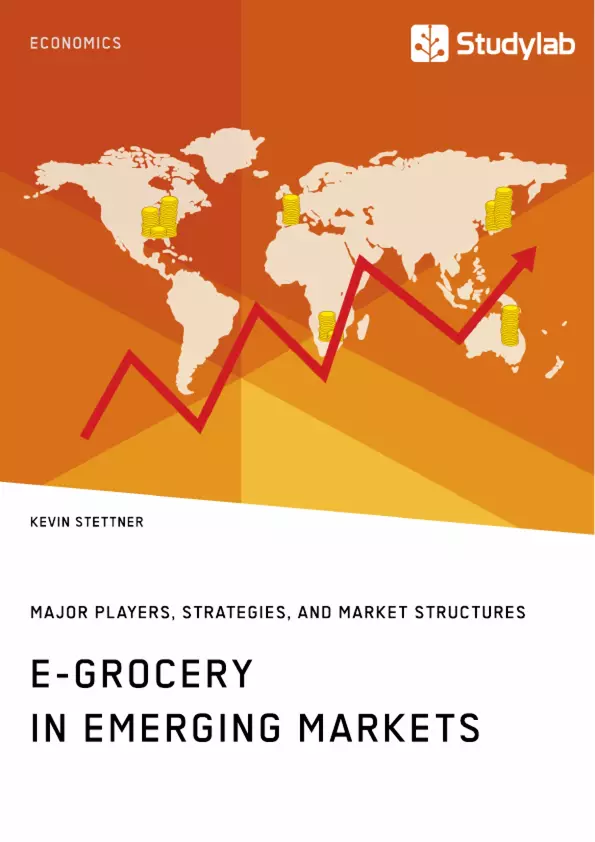E-grocery is the distribution of groceries via the online channel. It includes all fast-moving consumer goods such as fresh food or beauty and personal care items. Over the last years, it has become a global phenomenon. Consumers benefit from higher convenience, a wider range of product, potentially better deals and lower search costs.
Additionally, in certain emerging markets, expats mention increased food safety and familiarity with foreign goods as major advantages. Kevin Stettner gives an overview of e-grocery activities across 23 emerging markets. He identifies major players, their strategies and the underlying market structure.
Stettner’s analysis is complemented by taking into account the respective market environment. He identifies prototypical countries and compares them with developed markets. Which markets evolve better than developed markets? Which ones require further development in basic external conditions? Kevin Stettner describes the status quo of e-grocery.
In this book:
- Consumer Behavior;
- Competitive Strategies;
- E-Commerce;
- Internet;
- Online Shopping
Inhaltsverzeichnis (Table of Contents)
- 1 Introduction
- 2 E-Grocery Business Framework
- 2.1 Business Environment
- 2.2 Business Models
- 3 Review of Developed Markets
- 3.1 Market Conditions
- 3.2 Consumer Behavior
- 3.3 Competitive Strategies
- 4 Review of Emerging Markets
- 4.1 Asia
- 4.2 Europe
- 4.3 Latin America
- 4.4 Africa & Middle East
- 5 Prototypical Emerging Markets
- 5.1 China
- 5.2 Argentina
- 5.3 Czech Republic
- 6 Summary
Zielsetzung und Themenschwerpunkte (Objectives and Key Themes)
This book provides a comprehensive analysis of the e-grocery industry in emerging markets, examining the major players, strategies, and market structures. It offers insights into the business environment, consumer behavior, and competitive landscape in various regions, focusing on the challenges and opportunities for e-grocery growth.
- The evolution and current state of the e-grocery market
- E-grocery business models and strategies in emerging markets
- Consumer behavior and preferences related to online grocery shopping
- The competitive landscape and key players in the e-grocery industry
- Case studies of specific emerging markets (e.g., China, Argentina, Czech Republic)
Zusammenfassung der Kapitel (Chapter Summaries)
- Chapter 1: Introduction This chapter sets the stage for the book, outlining the scope and focus of the research. It introduces the concept of e-grocery and its significance in emerging markets.
- Chapter 2: E-Grocery Business Framework This chapter explores the business environment and models that underpin the e-grocery industry. It examines key factors influencing e-grocery development, including infrastructure, logistics, and technology. It also analyzes different e-grocery business models, such as pure-play online retailers, traditional retailers with online offerings, and click-and-collect services.
- Chapter 3: Review of Developed Markets This chapter analyzes the e-grocery landscape in developed markets, providing insights into market conditions, consumer behavior, and competitive strategies. It examines the drivers of e-grocery growth in developed countries and identifies key trends that are influencing the industry.
- Chapter 4: Review of Emerging Markets This chapter offers a comprehensive overview of the e-grocery market in emerging markets, focusing on four key regions: Asia, Europe, Latin America, and Africa & Middle East. It discusses the specific challenges and opportunities for e-grocery growth in each region, considering factors such as economic development, infrastructure, and consumer behavior.
- Chapter 5: Prototypical Emerging Markets This chapter focuses on three case studies of specific emerging markets: China, Argentina, and the Czech Republic. It examines the unique characteristics of the e-grocery market in each country, highlighting the factors driving growth, key players, and challenges.
Schlüsselwörter (Keywords)
This book explores the e-grocery industry in emerging markets. It examines the major players, strategies, and market structures, analyzing key concepts like online grocery shopping, business models, consumer behavior, competition, and market growth. It also focuses on specific regions and case studies, including China, Argentina, and the Czech Republic, offering insights into the challenges and opportunities for e-grocery development in these markets.
- Arbeit zitieren
- Kevin Stettner (Autor:in), 2019, E-Grocery in Emerging Markets. Major Players, Strategies, and Market Structures, München, GRIN Verlag, https://www.grin.com/document/458870



